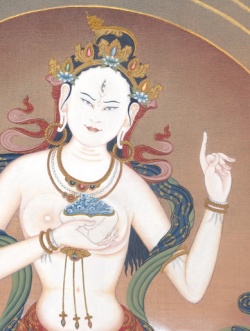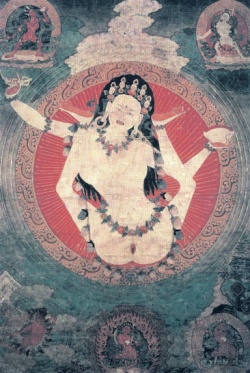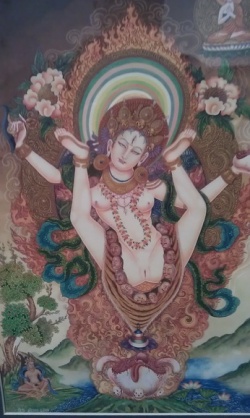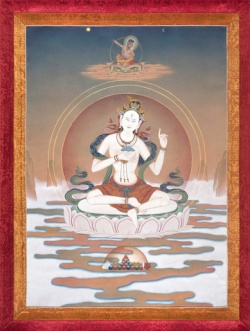Difference between revisions of "Sukhasiddhi"
m (Text replacement - "begging for food" to "begging for food") |
m (Text replacement - "one thing " to "one thing ") |
||
| Line 154: | Line 154: | ||
If we compare [[Niguma]] and [[Sukhasiddhi’s]] contributions to the [[Shangpa lineage]], [[Niguma’s]] definitely outnumber those of [[Sukhasiddhi]], but both [[taught]] [[Great Seal]] and a series of [[meditations]] called the [[Six Doctrines]] (each very different from the other and from those of [[Naropa]], although the [[subjects]] are the same). | If we compare [[Niguma]] and [[Sukhasiddhi’s]] contributions to the [[Shangpa lineage]], [[Niguma’s]] definitely outnumber those of [[Sukhasiddhi]], but both [[taught]] [[Great Seal]] and a series of [[meditations]] called the [[Six Doctrines]] (each very different from the other and from those of [[Naropa]], although the [[subjects]] are the same). | ||
| − | [[Niguma’s]] and [[Sukhasiddhi’s]] {{Wiki|biographies}} have | + | [[Niguma’s]] and [[Sukhasiddhi’s]] {{Wiki|biographies}} have one thing in common. |
Both women reached as high a level of [[realization]] as any of the great [[Indian]] [[masters]] without the {{Wiki|drama}} that we have come to associate with [[Dharma]] ([[Buddhist]] [[religious]] practice), particularly that of the early [[Marpa]] Instruction [[Lineage]]. | Both women reached as high a level of [[realization]] as any of the great [[Indian]] [[masters]] without the {{Wiki|drama}} that we have come to associate with [[Dharma]] ([[Buddhist]] [[religious]] practice), particularly that of the early [[Marpa]] Instruction [[Lineage]]. | ||
Revision as of 16:22, 30 January 2016
Sukhasiddhi is an Indian Buddhist Vajrayana teacher (Lama) and lady-master of meditation (dakini). She was born in West Kashmir, to a large, poor family. She is mother of three sons and three daughters. Once she gave a beggar the only food in the house and was expelled from home.
Sukhasiddhi’s accomplishment equaled that of Niguma.
Although they were both born in Kashmir, there is no record of any meeting between them.
They are cited together only as teachers of the same disciple, Kyungpo Naljor, yet according to the Nyingma tradition, they are related from past lives.
Jamgön Kongtrul writes in The History of the Sources of the Profound Treasures and the Treasure Revealers (p. 32b), that Niguma in a past life was none other than Mandarava, Guru Rinpoché’s foremost Indian disciple.
The identification of Sukhasiddhi with Yeshé Tsogyal, Guru Rinpoché’s foremost Tibetan disciple, and with her reincarnation as Machik Labdrön, is well known.
Here is the story of the woman known by the name Sukhasiddhi in Sanskrit or Dewai Ngödrup in Tibetan.
At one time, in the Moslem part of India Kashmir, there were 38,000,000 cities. In one of these—in the one called the Western Moslem City—there lived a couple with three sons and three daughters.
At one time, they became so extremely impoverished and destitute that they had only one jar full of rice left as their food supply. They agreed they should not eat this last provision and stored it in a hidden place. Then, the three sons went south in search of food. The three daughters went north.
The father went west. While they were gone, a very poor beggar came to the door asking for food. The mother, who had stayed home, opened the jar of rice and gave it to the beggar.
The father, unable to find food in the west, became weak with hunger. Remembering the vase full of rice, he turned back with the thought that they must use that as their food. The three sons also had no luck and turned back.
The three daughters also were compelled to come back empty-handed. All three parties returned from their search at about the same time.
When they convened at home, they said, "Mother, open the container of rice and give us some.
Already we were weak with hunger, and we have new become completely exhausted from our journey.
" The mother replied, "Thinking you would return with food, I gave the rice to an extremely poor and weary beggar who came asking for alms. So now we have nothing."
The father, sons and daughters replied in unison, "Even had you done something like this previously, it would not have been with our consent.
Not only did you not go with us in search of food; you robbed us of our earnings at the same time!" Saying this, they threw her out of the house.
From Kashmir, the old woman traveled west to Persia Orgyen. In Orgyen, all males were dakas and all females were dakinis.
Therefore, it was said that by merely traveling there, a person’s awareness would naturally become clear.
It happened to be harvest time, so the woman gathered some grains together and loaded them onto her back.
She carried this into a city and established herself as a beer seller.
At that time the master Birwapa, also known as Avadhutipa, was living in a nearby forest of Orgyen, where he practiced secret conduct with his consort yogini Avadhutima, who frequently went to the town to buy him beer.
Most often, she purchased beer from the old woman beer vendor, because the beer she sold was far more delicious than that sold by the other vendors.
One day, the old woman asked, "Yogini, after you buy my beer, who do you take it to?" The yogini replied, "In the forest of Yaki lives an excellent yogin.
I bring it to him." The old woman said, "Well, in that case, you do not need to pay for the beer", and gave her the very best portion of beer to take with her.
When the yogini returned to the forest, Birwapa said, "How is it that you were able to acquire this beer for free?"
She replied, "There is a new beer seller with devotion; she is unlike the other vendors we used to buy from.
I told her that my excellent lama lives in the forest and that I bring beer to him.
The beer seller was moved to devotion and gave me this beer to bring."
Birwapa said, "At all costs, I must deliver that old woman from the three realms of samsara."
So the yogini returned to the market and asked the old woman, "Will you come?"
The old woman felt very inclined to go, so she accompanied the girl to meet him, bringing with her a jug of beer and some pork.
During that very meeting, Birwapa bestowed upon her fully the secret practice, the four empowerments of the nirmanakaya chakra at the navel.
He also taught her the generation phase, completion phase and secret practices, along with instructions in the magnetizing activity. She transformed into a wisdom dakini right at that time.
At the time that she was thrown out of the house by her husband and children in Kashmir, she was 59 years old.
When she came to Orgyen and established herself as a beer seller, she was 60. When she met Birwapa and requested empowerment, she was 61.
Then, in the course of that one night, her 61 year old physical body purified itself and transformed into a youthful, attractive, very white rainbow body. Her silken hair flowed down her back.
She became as beautiful as a sixteen year old maiden, ravishing to behold, and sat up in the sky for seven days.
Thus, she became known as the miraculous dakini known as Sukhasiddhi. She then actually transformed into the Bhagavati Damema and became the secret consort of Birwapa.
Since even as of now she has not passed away, her wisdom eyes see sentient beings in the three realms throughout the six times.
Especially, she teaches the Dharma to those who have pure view. She directly blesses those engaged in the secret practice and those who supplicate her, and she confers upon them supreme and ordinary siddhi.
Those who read the life story of the wisdom dakini or merely hear her name will develop devotion. [Upon first hearing of her] I, Kyungpo Naljorpa, felt the seed of faith stir deep within my heart.
I traveled all over India in search of her.
I finally encountered her in the middle of the Sandalwood Medicine Forest in front and above a Tala tree.
I saw her from afar, floating up in space in the midst of swirling rainbow light surrounded by countless dakinis.
I offered her five hundred sang of gold and requested complete instruction. She fully bestowed upon me the four empowerments of the extraordinary secret practice.
She gave me oral instructions in the generation and completion phase aspects of the secret practice, the six yogas and the three gatherings. In particular, she conferred the special point of attaining Buddhahood in a just a few years or months...
From among my four root lamas Niguma, Rahula, the Hidden Yogin and Sukhasiddhi, Sukhasiddhi showed me the most exceptional kindness. Her first kindness was in conferring many prophesies.
Her second kindness was that she became my secret consort and bestowed all initiations without exception.
Her third kindness was in bestowing empowerments, practices and instructions. She was also very kind to say, "I will never be separate from you all throughout India and Tibet."
She also said, "Good practitioners in the future who engage in this secret practice will accomplish it."
Mochokpa said, "Once, when I was deeply engaged in intense practice, Sukhasiddhi came and gave many prophesies.
From that time forward, she was never separate from me." Lama Kyergangpa said,
"When I went to Lhasa to see the emanation, Sukhasiddhi taught me Dharma, including the completion phase exercises, and bestowed the four empowerments.
Now she is not separate from me for even a moment. Sangye Nyentön said,
"Once, when I was staying for awhile with the one known as Kyergangpa, I saw Sukhasiddi face to face. She repeated these words to me three times, "Rest in non-referential awareness".
From that time onwards, I have continuously seen her face before me.
I requested from her the four extraordinary empowerments. She made many prophesies such as, "You will become a yogin who masters the three doors to complete liberation."
And "If you and your students wish to attain Buddhahood in a matter of years or months, go to an isolated place and engage in this secret practice and you will accomplish the goal."
May there be auspiciousness.
Niguma’s teachings make up the bulk of the Shangpa Instruction Lineage’s meditation practices, yet it is Sukhasiddhi who occupies the center of the sacred circle when Kyungpo Naljor’s masters are recalled.
Kyungpo Naljor himself testified to her central position, as quoted in
The Story of the Wisdom Dakini, Sukhasiddhi, Whose Other Name [in Tibetan is Déwé Ng–drub- Accomplishment of Bliss:
Among my four principal spiritual masters, Niguma, Rahula, the hidden yogi [probably Métripa], and Sukhasiddhi, the kindest was Sukhasiddhi.
Her first great kindness was the bestowal of many transmissions.
Her later great kindness was to be my secret consort and to grant me every empowerment.
Her final great kindness was to give me directions for giving empowerment, along with profound instruction in meditation.
Moreover, she said she would remain inseparable from me throughout India and Tibet, a very great kindness, and that meditators in future generations would gain accomplishment by experiential cultivation of this secret meditation she taught.
(The Collection of Shangpa Masters’ Biographies, pp. 56-57)
In fact, Sukhasiddhi kept her promise to appear to future lineage holders, notably to each of the first four lineage holders after Kyungpo Naljor, and has thereby revitalized and added to the Shangpa teachings over the centuries.
If we compare Niguma and Sukhasiddhi’s contributions to the Shangpa lineage, Niguma’s definitely outnumber those of Sukhasiddhi, but both taught Great Seal and a series of meditations called the Six Doctrines (each very different from the other and from those of Naropa, although the subjects are the same).
Niguma’s and Sukhasiddhi’s biographies have one thing in common.
Both women reached as high a level of realization as any of the great Indian masters without the drama that we have come to associate with Dharma (Buddhist religious practice), particularly that of the early Marpa Instruction Lineage.
In looking at the Marpa lineage masters’ lives, we might wonder, "Does the path to enlightenment have to be so excruciating?" Niguma and Sukhasiddhi would answer, "No.
" While it’s true that Naropa and Milarepa in particular had difficult spiritual lives, we should recall that they were particularly difficult characters.
Before his awakening, Naropa had been a brilliant Buddhist university professor, one of the best of his time.
Yet his tight, solid, self-assured mind was so unfit for meditation, or instruction in the mind’s nature, that his teacher had him undergo hardships instead. For his part, Milarepa had practiced black magic and killed forty people before meeting his teacher.
Naropa and Milarepa were not average people and did not follow an average path to awakening.
Their stories are well loved throughout the Himalayas, but Tibet’s Buddhists also know many other "templates" for the path to enlightenment.
While we might not be able to attain enlightenment in an evening or a week, as Niguma and Sukhasiddhi did, we can absorb that possibility into our outlook.
Things can be light and easyówe receive pith instructions from a qualified teacher and we give ourselves permission to allow the teachings to guide us to awakening.
It could be as simple as that. And so it was for our two uncomplicated, straightforward dakinis.
She traveled to Udiana, thought to be the land of Dakas and Dakinis and there she met her guru Mahasiddha Virupa.
Very quickly Sukhasiddhi became completely realized and together with Niguma, Rahula, Maitripa and Vajrasapana was among the root teachers of Tibetan yogi Khyungpo Naljor, who later founded the Shangpa Kagyu tradition.
Sukhasiddhi is a wisdom dakini who is associated with a few Vajrayana lineages, namely as past life incarnations of Yeshe Tsogyal (Nyingma)and Machig Labdron (Chod , but she is predominantly known for her activities within the Shangpa lineage.
Often shadowed by the prominence of the wisdom dakini Niguma, her accomplishments were of equal importance to those of her dakini sister.
She was born in Kashmir into the life of an impoverished housewife. Until the age of fifty nine she struggled with the household duties of a mother of six.
An act of kindness directed towards a wandering sadhu, which left the family with nothing to eat, resulted in her being banished from the household. Homeless, she then wandered westward to Oddiyana (Swat Valley in Pakistan) where she began to make alcohol to sell so that she could survive.
A regular customer of hers, a female adept named Avadhuti-ma would buy alcohol for her partner, the mahasiddha Virupa, who was in retreat.
On one visit she gave some alcohol to Avaduti-ma as an offering to Virupa.
Upon receiving her offering, Virupa sent word asking if she would like to receive teachings from him.
She did, and soon after went to visit Virupa with two containers of alcohol and some pork as further offerings.
Upon receiving empowerment and instruction from Virupa, Sukhasiddhi attained full enlightenment at the age of sixty one.
It is said that her physical body became like a rainbow.
She is often depicted as a light skinned sixteen year old, mostly with a peaceful countenance, but occassionally semi-wrathful. Sukkasiddhi became one of Kyungpo Naljor’s four main masters, the others being Niguma, Rahula and Metripa.
Sukhasiddhi
The life story of Sukhasiddhi is very wonderful.
When she was about sixty years old, or maybe sixty-five, she experienced a great deal of suffering.
Due to that, she engaged in the practice of vajrayana and attained a state where she appeared like a sixteen-year-old girl.
Her story is that she and her family were very poor and they got to the point where they only had one container of rice left.
So, her husband and son went out to look for food. They went all over, searching, begging for food.
Though they went through a great deal of difficulties, they were unable to find any food.
Thinking that they had one container of rice left, they went back home to eat it. However, while they were gone, Sukhasiddhi, out of great compassion, had given the food to a beggar.
When her husband and son came back, they were very hungry and expecting to eat the last container of rice, but they found that there was no rice left, that she had given it away to a beggar.
They were very upset and very angry with her, saying that though they were all experiencing a great deal of suffering, a great deal of problems, she had given their last food away.
They were so upset with her that they threw her out of the house.
Then she became very upset and cried about her husband and son throwing her out of her home.
Leaving her town, she gave rise to a very strong renunciation for samsara, and based upon this very strong renunciation and good fortune, she was able to meet with a siddha from whom she received oral instructions.
She meditated upon them and realized mahamudra, the supreme siddhi.
Her mind was liberated within this state of luminosity, and her body became an empty form like a rainbow.
She looked like a sixteen- year-old girl. She unified luminosity and the illusory body.
It is said that even at this time she resides in India and can be found in various places there.



